U.S. NAVY FLIERS FIND RICH TARGETS IN MARIANAS
Off the Mariana Islands, Central Pacific • June 12, 1944
On this date in 1944 in the Marianas, U.S. carrier aircraft began attacking Japanese defenses on Saipan, Tinian, and Guam in preparation for the 3‑week battle for the archipelago’s administrative center, Saipan. Eight hundred U.S. warships carrying 162,000 fighting men were set to smash into the outer defenses of the Japanese Empire. By July 9 U.S. Marines had secured Saipan, an important Japanese military base and home to a large population of Japanese civilians, calling the battle for that island “the decisive battle of the Pacific offensive.” The Japanese defeat in the Marianas ripped a hole in Japan’s so-called “Absolute National Defense Zone,” once considered essential by the country’s military leaders to continue the war and protect the Japanese Home Islands (Hokkaidō, Honshū, Kyūshū, and Shikoku, comprising an area the size of California).
Gone now were the Japanese forward bases in the Central Pacific, making the American submarine blockade of Japan more effective than ever. In the first 6 months of 1944, U.S. submarines sank over 300 enemy freighters. During all of 1944 Japan managed to import just 5 million barrels of oil, although the nation consumed over 19 million barrels. Nineteen forty-four saw the total tonnage of Japanese imports shrink to less than half that of 1941. The war guidance unit of the War Ministry at the Imperial General Headquarters reached 3 conclusions: First, the empire had no prospect of regaining its previous strength; secondly, strength would gradually decline; and, thirdly, the nation’s leaders should seek an end to the war immediately.
Together with his war cabinet, Prime Minister Hideki Tōjō—the architect and scapegoat of Japan’s failed wartime policies—resigned in disgrace. His successor, Gen. Kuniaki Koiso (July 22, 1944, to April 7, 1945), however, believed that Japan needed to win a battle against the U.S. in the Philippines to gain leverage in any peace negotiations. Koiso’s hopes were crushed in the Battle of Leyte Gulf (October 23–26, 1944), which involved nearly 500 ships; it was the most sprawling and spectacular naval battle in history. When the smoke cleared, the Japanese had lost most of what remained of their naval and air power.
The U.S. went on to take the Philippine’s main island of Luzon, which allowed the U.S. to further cut off the sea lanes between the Japanese Home Islands and the imports the Japanese economy and war machine desperately needed. By the end of 1944, the number of U.S. submarines in the Pacific alone stood at 200. Japanese soldiers in the Philippines complained that one could walk from the Philippines to Japanese-held Singapore on U.S. submarine periscopes.
The Mariana Islands Campaign, June–August 1944
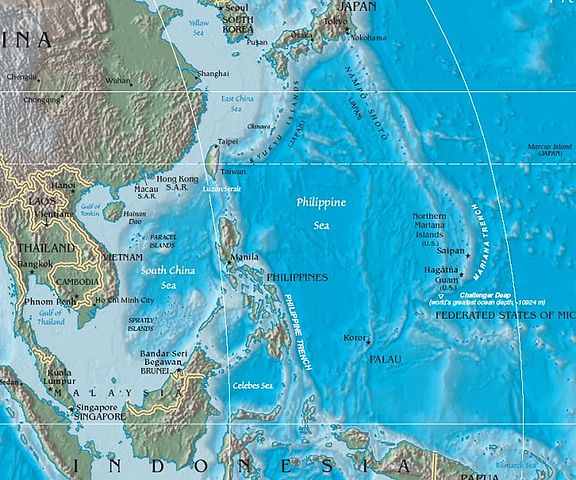 |
Above: The arc-shaped Mariana archipelago can be seen in the right half of the map in relation to Japan (to the north), New Guinea (to the south), and the Philippine Sea (to the east). When the Marianas Campaign was over (June to August 1944), 60,000 Japanese ground troops and most of Japan’s carrier air power were annihilated. Following amphibious landings in the Marianas and, to the southwest, the Palau Islands (Peleliu and Angaur between September and November 1944), Allied forces continued their ultimately successful campaign against the enemy by landings in the Philippines in October 1944 and the Volcano (Iwo Jima) and Ryukyu (Okinawa) islands beginning in February 1945. The Allied amphibious invasion of the Japanese Home Islands planned for late in the year was rendered moot by 2 city-blasting atomic bombs delivered by 2 specially configured B‑29 Superfortresses of the United States Army Air Forces on August 9 and 11, 1945.
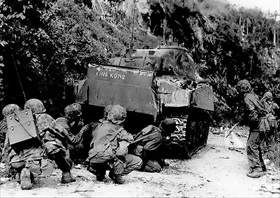 | 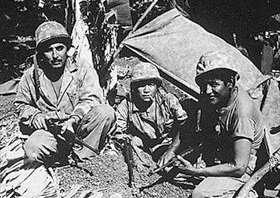 |
Left: One day before U.S. Marine Lt. Gen. Holland “Howlin’ Mad” Smith declared Saipan secure, U.S. Marines are shown here taking cover behind an M4 Sherman tank in an operation to clean out the northern end of the island. Although major fighting had officially ceased on July 9, 1944, pockets of Japanese resistance continued, and in September Marines began patrols into Saipan’s interior to extract soldiers and civilians still holding out in the jungles.
![]()
Right: Roughly 400–500 Native Americans in the U.S. Marine Corps transmitted tactical messages over military telephone or radio communication nets using formal or informally developed codes built upon their native languages. Navajo code talkers were the most famous of the World War II code talkers (they were called “Arizona” in battlefield shorthand), but Hopi, Cherokee, Choctaw, Lakota, Meskwaki, and Comanche code talkers were employed as well; in all, 16 Native American tribes served in the U.S. Army, Navy, and Marine Corps. Even speakers of Basque, a European language, were used to encode and decode messages. The movie Windtalkers, released in 2002, brought awareness to the wider world of the achievements of the Navajo code talkers in the Pacific War.
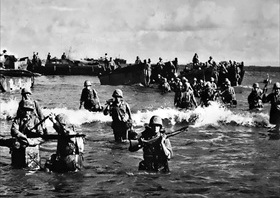 | 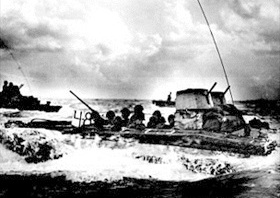 |
Left: The U.S. victory on Saipan made nearby Tinian the next logical step in the Marianas Campaign. In this photo Marines wade onto Tinian’s beaches. The battle to secure the island lasted from July 24 to August 1, 1944. It was from Tinian’s “North Field” that the Enola Gay and Bockscar began their epic missions to bomb Hiroshima and Nagasaki, respectively.
![]()
Right: An amphibious landing craft known as a Water Buffalo (aka, Landing Vehicle, Tracked [LVT]), loaded with Marines, churns through the sea bound for Tinian’s beaches, July 1944.
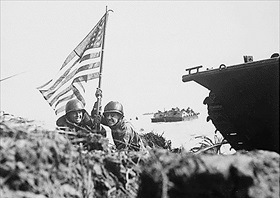 | 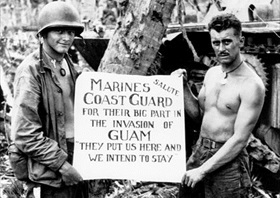 |
Left: Eight minutes after Marines and Army assault troops landed on Guam, the largest of the Marianas, on July 20, 1944, 2 GIs planted the American flag. Fighting on Guam ended on August 10, 1944. Guam had been the first American territory captured by the Japanese in the aftermath of Pearl Harbor.
![]()
Right: Marines on Guam show their appreciation to the U.S. Coast Guard. During amphibious landings in the Pacific, European, and Mediterranean theaters, a large percentage of the landing craft coxswains were Coast Guard enlisted men, almost all young, many still teenagers, who brought men and supplies ashore and returned with the wounded and dead. Coast Guardsmen also manned or partially manned assault transports as well as landed with Marines on Pacific beaches.
Account of U.S. Marines During the Battle for the Mariana Islands
![]()

 History buffs, there is good news! The Daily Chronicles of World War II is now available as an ebook for $4.99 on Amazon.com. Containing a year’s worth of dated entries from this website, the ebook brings the story of this tumultuous era to life in a compelling, authoritative, and succinct manner. Featuring inventive navigation aids, the ebook enables readers to instantly move forward or backward by month and date to different dated entries. Simple and elegant! Click
History buffs, there is good news! The Daily Chronicles of World War II is now available as an ebook for $4.99 on Amazon.com. Containing a year’s worth of dated entries from this website, the ebook brings the story of this tumultuous era to life in a compelling, authoritative, and succinct manner. Featuring inventive navigation aids, the ebook enables readers to instantly move forward or backward by month and date to different dated entries. Simple and elegant! Click 











